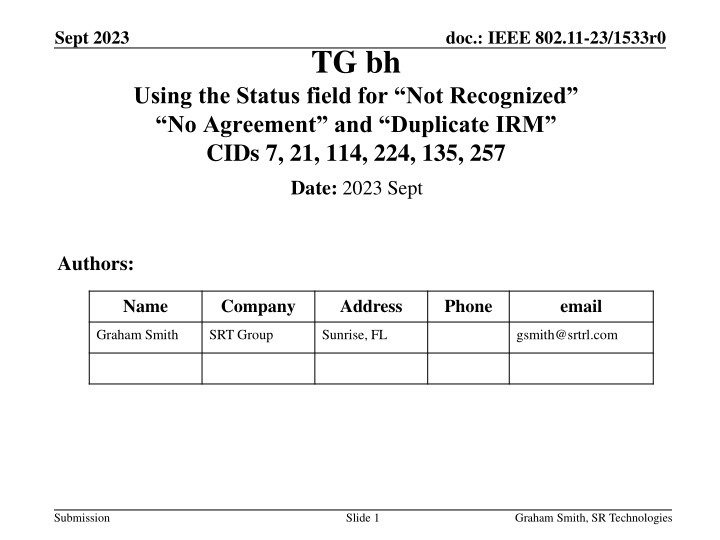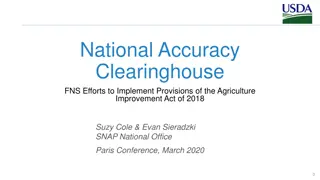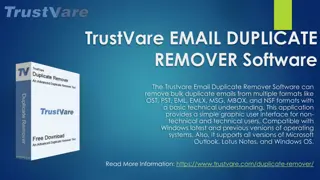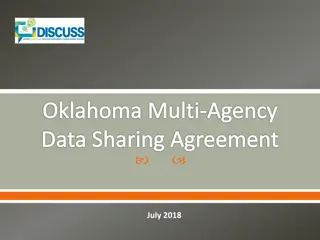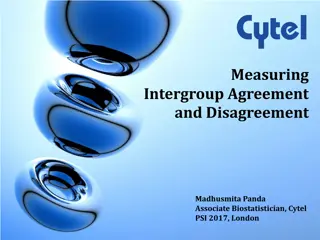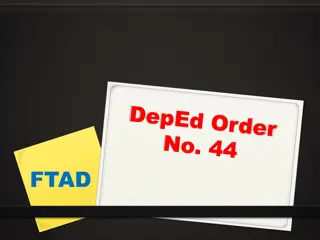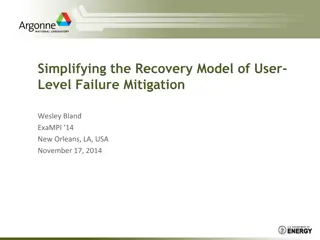Using the Status Field for Not Recognized No Agreement and Duplicate IRMCIDs
This document discusses utilizing the status field in IEEE 802.11-23/1533r0TG.bh for scenarios involving Not Recognized No Agreement and Duplicate IRMCIDs. The focus is on enhancing communication protocols to address these issues effectively, as proposed by Graham Smith from SRT Group. The content delves into the specific identification numbers (7, 21, 114, 224, 135, 257) associated with this approach and its significance in network operations and management.
Download Presentation

Please find below an Image/Link to download the presentation.
The content on the website is provided AS IS for your information and personal use only. It may not be sold, licensed, or shared on other websites without obtaining consent from the author.If you encounter any issues during the download, it is possible that the publisher has removed the file from their server.
You are allowed to download the files provided on this website for personal or commercial use, subject to the condition that they are used lawfully. All files are the property of their respective owners.
The content on the website is provided AS IS for your information and personal use only. It may not be sold, licensed, or shared on other websites without obtaining consent from the author.
E N D
Presentation Transcript
Sept 2023 doc.: IEEE 802.11-23/1533r0 TG bh Using the Status field for Not Recognized No Agreement and Duplicate IRM CIDs 7, 21, 114, 224, 135, 257 Date: 2023 Sept Authors: Name Company Address Phone email Graham Smith SRT Group Sunrise, FL gsmith@srtrl.com Submission Slide 1 Graham Smith, SR Technologies
Sept 2023 doc.: IEEE 802.11-23/1533r0 Intro Comments have been made on D1.0 that raise concerns with: 1. What does a STA or AP do if not recognized 2. What if the IRM and Device ID do not agree? CIDs 135, 224, 257 AP thinks that the IRM and the Device ID are not identifying the same STA. 3. What if STA gives a Duplicate IRM? CIDs 7, 21, 114 STA provides a new IRM that is already in the APs stored list. The TG has agreed to include a Status field in both the Device ID and the IRM IEs. This presentation looks at using the Status field to address these concerns and to present options for way ahead. Submission Slide 2 Graham Smith, SR Technologies
Sept 2023 doc.: IEEE 802.11-23/1533r0 Recap - 4w HS STA AP Msg 1 TA = IRM Msg 2 Device ID Msg 3 Device ID Status, IRM Status New IRM Msg 4 When a STA associates using 4w HS Device ID STA sends Device ID in msg 2 AP sends Status field in msg 3 IRM AP sends status field in msg 3 STA sends new IRM in msg 4 Submission Graham Smith, SR Technologies Slide 3
Sept 2023 doc.: IEEE 802.11-23/1533r0 Not recognized Device ID STA AP Msg 1 TA = RCM Msg 2 Device ID Msg 3 Device ID KDE, Not Recognized AND new device ID Msg 4 Proposal is that AP treats STA as a new entry and provides a new device ID Submission Slide 4 Graham Smith, SR Technologies
Sept 2023 doc.: IEEE 802.11-23/1533r0 Not recognized - IRM STA AP Msg 1 TA = IRM Msg 2 Msg 3 IRM KDE, Not Recognized Msg 4 New IRM Proposal is that AP treats STA as a new entry. Submission Slide 5 Graham Smith, SR Technologies
Sept 2023 doc.: IEEE 802.11-23/1533r0 IRM OK, Device ID not recognized STA AP Msg 1 TA = IRM Msg 2 Device ID Device ID KDE, IRM KDE recognized Not Recognized AND new device ID Msg 3 Msg 4 IRM KDE new IRM Both AP and STA are clear as to what happened AP had IRM in store, but not the device ID. Submission Slide 6 Graham Smith, SR Technologies
Sept 2023 doc.: IEEE 802.11-23/1533r0 Mismatch- What happens? STA is using an IRM to associate STA sends a Device ID in msg 2, AP has both the IRM and the device ID in store, BUT FOR DIFFERENT STAs MISMATCH What has happened? STA or AP error? Can it happen? AP has to have both a valid IRM and a valid Device ID stored, but not for same STA Proposal #1 Send status code not recognized in BOTH KDEs AP provides new device ID (msg 3) STA provides new IRM (msg 4) STA and AP know what happened, and simply start again. Same instructions as per not recognized . Submission Slide 7 Graham Smith, SR Technologies
Sept 2023 doc.: IEEE 802.11-23/1533r0 Text for Not Recognized Device ID If an AP sets Device ID element or Device ID KDE with the Device ID status field set to 1 indicating Not Recognized , then the AP may also provide, in that same Device ID element or Device ID KDE, a new device ID. Note: An AP might set a Device ID status field to 1 indicating Not Recognized for any reason if the AP cannot unequivocally identify the non-AP STA shared identity state. IRM The non-AP STA, on receipt of an IRM Status field of value 1, indicating the AP has not recognized the IRM, may either continue to associate to the AP and provide a new IRM in an IRM KDE in message 3 of the 4-way handshake or, when using FILS authentication, including an IRM element in the Association Request frame, in or disassociate. Note: An AP might set an IRM status field to 1 indicating Not Recognized for any reason if the AP cannot unequivocally identify the non-AP STA shared identity state. Submission Slide 8 Graham Smith, SR Technologies
Sept 2023 doc.: IEEE 802.11-23/1533r0 What about a Mismatch status code? Submission Slide 9 Graham Smith, SR Technologies
Sept 2023 doc.: IEEE 802.11-23/1533r0 Mismatch Proposal #1 Use Not recognized STA AP Msg 1 TA = IRM Msg 2 Device ID Device ID KDE, IRM KDE Not recognized Not Recognized AND new device ID Msg 3 Msg 4 IRM KDE new IRM Same rule as before If not recognized assume a restart Simple rule. Submission Slide 10 Graham Smith, SR Technologies
Sept 2023 doc.: IEEE 802.11-23/1533r0 If we had Mismatch STA AP Msg 1 TA = IRM Msg 2 Device ID Device ID KDE, IRM KDE Mismatch Mismatch AND new device ID Msg 3 Msg 4 IRM KDE new IRM Rule as before assume a restart i.e., same rule but now an added status. Need to describe/ define the mismatch condition Submission Slide 11 Graham Smith, SR Technologies
Sept 2023 doc.: IEEE 802.11-23/1533r0 Text required if Mismatch status code Device ID Text When a non-AP STA receives an AP Identity frame with the Identifier Status equal to Not Recognized or Mismatch , it must assume that no shared identity state exists with the AP or ESS (as per the concepts of 12.2.10) or , in the case of Mismatch no common Devise ID and IRM shared identity exists, and the non- AP STA must (re)establish any desired, shared identity state per the procedures previously described. If an AP sets Device ID element or Device ID KDE with the Device ID status field set to 1 indicating Not Recognized , or set to 2 indicating Mismatch , then the AP may also provide, in that same Device ID element or Device ID KDE, a new device ID, thus establishing a new shared identity. Note 1: An AP might set a Device ID status field to 1 indicating Not Recognized for any reason if the AP cannot unequivocally identify the non-AP STAshared identity state. Note 2: An AP might set a Device ID status field to 2 indicating Mismatch if the device ID provided by the non-AP STA does not correspond to the non-AP STA indicated by the IRM. Submission Slide 12 Graham Smith, SR Technologies
Sept 2023 doc.: IEEE 802.11-23/1533r0 IRM Text In the case that the non-AP STA has also provided a device ID and the AP does not recognize the device ID and the IRM as shared identities for the same non-AP STA, the IRM Status field of the IRM KDE or IRM element is set to 2 to indicate a mismatch. The non-AP STA, on receipt of an IRM Status field of value 1 or 2, indicating the AP has not recognized the IRM, or that there is a mismatch, may either continue to associate to the AP and provide a new IRM in an IRM KDE in message 3 of the 4-way handshake or, when using FILS authentication, including an IRM element in the Association Request frame, thus establishing a new shared identity,in or disassociate. Note: An AP might set an IRM status field to 1 indicating Not Recognized for any reason if the AP cannot unequivocally identify the non-AP STA shared identity state. Plus new line in the Status code Add line to Table 9-322aq and Table 9-322ar and edit row three. 2 Mismatch IRM and Device ID recognized but as shared identities for different STAs 3-255 Reserved Submission Slide 13 Graham Smith, SR Technologies
Sept 2023 doc.: IEEE 802.11-23/1533r0 Proposed In TG discussions there was a view to reject the mismatch comments as not easy to agree what is going on or how to define it. Even if we have a mismatch status code the result is the same. Straightforward rule for Device ID or IRM to assume restart is they get a not recognized status. AP can set it easily in all situations. Recommend not recognized approach Submission Slide 14 Graham Smith, SR Technologies
Sept 2023 doc.: IEEE 802.11-23/1533r0 What about FILS? Order is: FILS Authentication Request FILS Authentication Response (Keys established) FILS Association Request FILS Association Response STA sends new IRM AND device ID AP sends Device ID and IRM elements - Device ID Not recognized AP sends Device ID status AND new Device ID in Association Response - IRM Not recognized AP sends IRM status in Association Response (already has new IRM) Same rule not recognized or mismatch provide new device ID/IRM and treat as new. Submission Slide 15 Graham Smith, SR Technologies
Sept 2023 doc.: IEEE 802.11-23/1533r0 What about PASN? Order is STA to AP AP to STA STA to AP Authentication Msg 1 (Clear) Authentication Msg 2 (encrypted) Authentication Msg 3 (encrypted) Procedure: Device ID 1. Temp ID sent in Msg 1 (in the clear). 2. AP sends ID KDE in msg 2, with Status field AP always provides NEW (temporary) ID in msg 2 to be used in next PASN Authentication. 3. If not recognized , No real difference, STA/AP just know it is a restart. Procedure: IRM 1. IRM = TA 2. AP sends IRM KDE in msg 2, with Status field 3. STA sends new IRM in msg 3 4. If not recognized in msg 2, No real difference, STA sends new IRM in msg 4 and AP/STA know it is a restart. Mismatch is therefore covered. Is Mismatch a real thing for PASN? Would a STA use both? Are we happy with the Temp ID (for me this is NOT Device ID) Submission Slide 16 Graham Smith, SR Technologies
Sept 2023 doc.: IEEE 802.11-23/1533r0 Summary If Device ID status is not recognized , the new device ID provided in same KDE or element. If IRM status is not recognized , the new IRM is sent as normal, but STA understands this is a new start. Works for 4w HS, FILS and PASN. If we had a special mismatch status, nothing is actually changed or gained, except that the definition of when to use mismatch is now required. i.e., a lot more text required. Propose to go with not recognized approach Submission Slide 17 Graham Smith, SR Technologies
Sept 2023 doc.: IEEE 802.11-23/1533r0 Probabilities of Duplicate IRM Probabilities: 100 stored IRMs - 1 in 14 billion 1000 stored IRMs 1 in 141 million 10000 stored IRMs 1 in 1.4 million Doing it twice? Astronomical. What do these probabilities mean? If AP has 1000 STAs registering per day, and 1000 stored IRMs, how long before 0.5 chance of duplicate? 192 YEARS 10,000 stored addresses and 1000 STAs per day? 1.92 years So, need to solve this is very dependent upon how many STAs do we expect an ESS to store. In any event it s rare. Submission Slide 18 Graham Smith, SR Technologies
Sept 2023 doc.: IEEE 802.11-23/1533r0 Duplicate IRM 4w HS New IRM is sent in msg 4, AFTER the IRM status has been sent by the AP in msg 3. Hence, too late. SOLUTION #1 STA sends the new IRM in msg 2 AP sends status in msg 3 Duplicate STA sends new IRM in msg 4. Problem - still does not work for FILS SOLUTION #2 STA associates, AP sends action frame with IRM IE status field set to Duplicate STA sends action frame with new IRM in the IRM IE Submission Slide 19 Graham Smith, SR Technologies
Sept 2023 doc.: IEEE 802.11-23/1533r0 Solution #3 Simply use Duplicate STA A provides new IRM in msg 4 or Association Request (FILS) AP sees that it is a duplicate (previously provided by STA B) AP tags that Address as a duplicate STA B comes back. AP notes the duplicate address and sends duplicate as status code STA B provides new IRM, assumes a re-start. Address is still tagged as a duplicate until another STA tries to use it STA A comes back, AP notes the duplicate address and sends duplicate (aside could just send not recognized no difference) STA A provides new IRM, assumes a re-start. Address is now cleared in AP Submission Slide 20 Graham Smith, SR Technologies
Sept 2023 doc.: IEEE 802.11-23/1533r0 Text for Option #3 The non-AP STA, on receipt of an IRM Status field of value 1, indicating the AP has not recognized the IRM, may either continue to associate to the AP and provide a new IRM in an IRM KDE in message 3 of the 4-way handshake or, when using FILS authentication, including an IRM element in the Association Request frame, thus establishing a new shared identity with the AP, or disassociate. If an AP has stored the same IRM for two non- AP STAs, then if a STA uses that IRM to associate or authenticate then AP shall set the IRM status field to 1 indicating Not Recognized . Submission Slide 21 Graham Smith, SR Technologies
Sept 2023 doc.: IEEE 802.11-23/1533r0 Solution #1, #2 or #3 #1 Works great for 4w HS. Would require FILS to send a new Association Request Might work but undefined behavior at the moment. #2 Works for 4w HS, FILS and PASN Requires new Action frames (is it worth it for very rare event?) #3 Simple and does not create any new rule Does require STA to start again (but this is very rare) Propose to use duplicate status so that STA knows why, but effect is the same so could use not recogized Submission Slide 22 Graham Smith, SR Technologies
Sept 2023 doc.: IEEE 802.11-23/1533r0 Proposal Same procedure as not recognized . Add text to say that AP sends not recognized if duplicate IRM. Keeps everything simple and just one rule. Device ID Always provide a new device ID in KDE or element together with status not recognized , IRM - Always provides a new IRM anyway, just assumes a restart for not recognized . IRM duplicate Option 1 simply use not recognized when STAs return Option 2 add new action frames to tell STA to provide another IRM Submission Slide 23 Graham Smith, SR Technologies
Sept 2023 doc.: IEEE 802.11-23/1533r0 Straw Polls 1. Do you agree that no special mismatch case need be defined, and not recognized status is sufficient? Y/N/A 1. For duplicate IRM do you prefer (remember this is rare event: A. Addition of Action frames? B. Wait for next association and use duplicate status with same rule as not recognized ? Requires new status code and repeat of same rule as per not recognized C. Wait for next association and use not recognized status? STA knows what to do, but not why (same rule as not recognized ) A/B/C/no view Submission Slide 24 Graham Smith, SR Technologies
